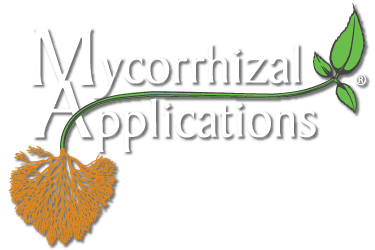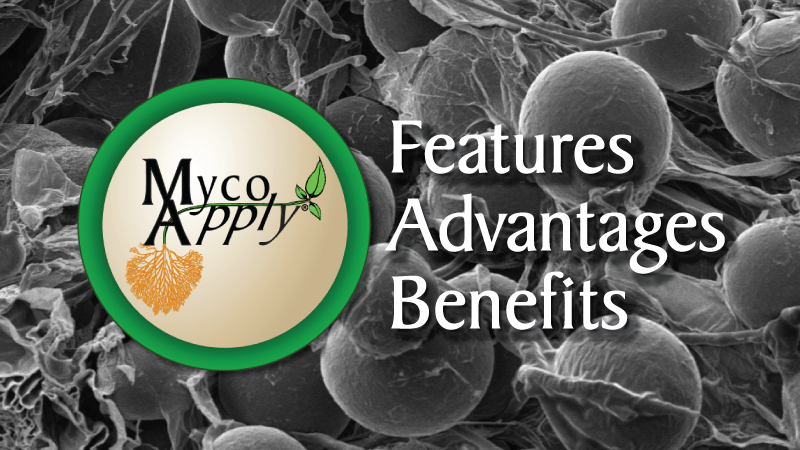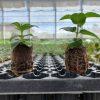“Mycorrhizae” is one of those technologies that most growers have heard of, know something about, but are not quite sure how it would positively impact their growing operation. When I talk with a grower at a tradeshow or visit their operation, the first thing they always want to know is why they should use MycoApply® professional mycorrhizal inoculum. Behind the “Why” is the underlying question: “How will the use of MycoApply® mycorrhizae in my greenhouse or nursery benefit me as a grower?” Unlike many other products, where there is a clear path from feature to advantage to benefit, this is not always the case with mycorrhizae. Before I can identify the benefits a grower will receive, I first need to learn about their business, production process, customer base, and distribution methods. Then, if mycorrhizae is a good fit for the operation, I need to start at the beginning and explain the science behind mycorrhizae.
The science behind how mycorrhizae interacts with plants has been established by research completed and compiled over the past hundred years. What has changed recently is how growers are growing. No longer do most growers grow under high nutrient levels. These early horticultural methods of over-feeding changed after growers read the researcher illustrating that “soft” plants produced by high feed rates were more prone to diseases and insect issues. Lower fertility rates were also adopted to control plant size as a wider variety of genera were sold at garden retailers. And the final straw on the heavy feeding of plants was economics. Growers can save money if they fertilize less. All these factors have changed the way plants are grown. Plants grown using modern horticultural practices are now leaner and better able to handle the stresses of the modern retail garden environment.
When Mycorrhizae Applications started in the mid 1990’s the “soft” production protocol was still the norm for most growers. We started like most of our competitors today with only one species of endomycorrhizae: Glomus intraradices. This is a great “generalist” species of mycorrhizae, but as with any organism, it has its limits. And for growers that trialed mycorrhizae during this time, the high fertility rates suppressed the benefits that the single species of mycorrhizae could offer. Times have changed on the mycorrhizal product selection front. Today, Mycorrhizal Applications offers a four-species endomycorrhizal consortium that allow growers to benefit from mycorrhizae in a greater variety of production regimes and under a broader range of fertility plans. Our current offering now includes a mycorrhizal species that continues to perform even when phosphorus levels are high. Now that we have covered the science behind why mycorrhizae make sense for today’s growers, we are now ready to discuss the central “Feature” of mycorrhizae.
What is the main Feature of MycoApply® mycorrhizal products?
Simply stated, the central feature of mycorrhizae is that these beneficial organisms work with the plant to expand the plant’s room mass and absorption area. You will have noticed that I did not say expand the plant roots, and this is because most of the expansion of the root mass is due to the development of a hyphal web that extends far beyond the most extended root. This can mean an extension of up to 2 feet beyond the most outer roots, reaching out beyond the “nutrient depletion zone” to gather resources for the plant and deliver them to the root system. The increased absorptive area is hard for most of us to image unless we view a 3-D root image. Not only do the act as a living extension of the plants roots, helping them reach farther into the soil, the mycorrhizal hyphae are in fact better than roots at absorption of water and nutrients. Nutrient and water can be absorbed along the entire length of the hyphae compared with just the tip for roots and root hairs. On top of that, mineral nutrient uptake through hyphae can come from both the soluble and insoluble pool of nutrients, as mycorrhizal fungi are able to solubilize the tightly-bound insoluble nutrients in the growing media or soil. And to ensure uptake efficiency, mycorrhizal hyphae allow for greater inflows through their system. In summary, plants with mycorrhizal relationships have a better developed root system. And as the old horticultural adage goes “A plant with better roots leads to a better overall plant.”
What are the Advantages of MycoApply® mycorrhizal products?
The development of the expanded root mass leads us to two major advantages for plants grown with MycoApply® mycorrhizae. The first of these advantages is that mycorrhizae help plants to be more efficient at the uptake of nutrients. Mycorrhizae can store nutrients during times of excess and make them available during times of plant need, shortages, or stress. Since the long-term livelihood of the mycorrhizae is linked to the long-term livelihood of the plant, the mycorrhizae will act as a nutrient buffer moderating the supplies of nutrients made available to the plant. In addition, mycorrhizae have the ability reduce the stress of high EC conditions or water. One of the more valuable and unique traits of mycorrhizae is their ability to find and modify nutrients found in the soil and transform them into a form the plant can use. A good example of this is when you apply an Ammonium-based fertilizer and the mycorrhizae transforms it into a Nitrate form the plant can readily use. Mycorrhizae also can transform low availability organic nutrients into forms the plant can use.
The main take away from this discussion on mycorrhizae and nutrients is the fact that mycorrhizae allow your plants to better utilize the fertilizer you apply. You get more value for the costs (product and labor) of applying nutrients. This concept applies whether you are feeding with a water soluble, controlled release or organic nutrients. And on longer-term crops, you can even apply lower levels of nutrients. An additional benefit is that you can reduce the Nitrogen & Phosphorus run off from your operation, because the plant is utilizing more of what you apply, and less is running out of the bottoms of those pots. The more consistent supply of nutrients reduces plant stress and allows the plant to prosper throughout its life cycle.
Mycorrhizae’s second advantage is improved extraction of water from the rhizosphere. Mycorrhizae can store water during times of excess and make it available during times of need by the plant. Excess water is actually stored in the hyphae and other mycorrhizal structures. Just like with nutrients, the mycorrhizae act as a buffer modulating the flow of water to the plant. This more consistent flow of water to the plant reduces plant stress and allows the plant to thrive.
What are the Benefits of MycoApply® mycorrhizal products?
When it comes to benefits, as I said before, the benefits vary depending on the type of grower and the grower’s customer type. I will try to outline this through a few examples.
Grower/Retailer
- Plants will start to benefit four weeks after application → less nutrient and drought stress.
- The grower will start to see benefits up to eight weeks after application → more flowering in plants, greater shelf appeal.
- Plants will look better and have the potential to sell better through retail → darker foliage, higher perceived customer value.
- Customers have improved success in their gardens → reduced transplant shock/less plant loss and greater yields, increased store customer loyalty.
Large Grower/Box Retailer
- Plants will start to benefit four weeks after application → less nutrient and drought stress.
- The grower will start to see benefits up to eight weeks after application → more uniform crop, more bench run for picking and shipping.
- Plants will look better and have the potential to sell better through retail → less potential for wilt and lighter foliage, higher pay by scan.
- Customers have improved success in their gardens → reduced transplant shock and greater yields, less plant returns, increased appreciation by retailer.
Commercial Grower/IGC& Landscape Customers
- Plants will start to benefit four weeks after application → less nutrient and drought stress.
- Grower will start to see benefits up to eight weeks after application → improved plant health.
- Plants will look better and have the potential to sell better through retail → plants look better coming off the truck, quicker selling of plants by retailer.
- Customers have improved success in their gardens → improved garden performance, more sell through by retailer/landscaper, more follow-up orders.
Hopefully through this article you have become more aware of the features and advantages of mycorrhizae and the potential benefits you as a grower can realize by incorporating mycorrhizae into your production protocol. If you would like to learn more about MycoApply® mycorrhizae and discuss with a Sales Account Manager how it might benefit your growing operation please send an email to inquiries@mycorrhizae.com or call (866) 476-7800.
Article by: Blair Busenbark, Mycorrhizal Applications Sales and Marketing Manager
November 20, 2018







